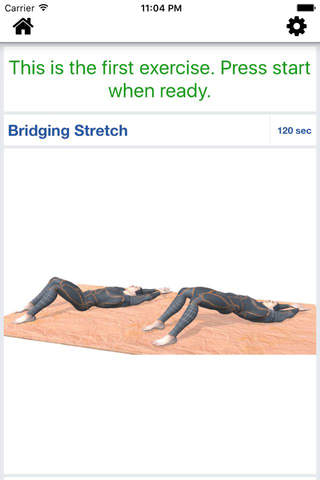
10 Min Physical Therapy exercise for low back pain - Workout for basic core and dynamic stabilisation app for iPhone and iPad
Developer: Laurentiu Gheorghisan
First release : 09 Nov 2015
App size: 10.68 Mb
Most physical therapy programs designed to treat low back pain and some radicular pain (pain radiating down the leg) will include a combination of the following types of therapeutic exercise:
Stretching
Proper stretching of the muscles along with active exercise will help maintain normal range of motion and provide relief for muscles that are often suffering disuse atrophy (shrinking muscles from lack of use) or in spasm from inappropriate posture or nerve irritation.
For many patients it is best to follow a stretching routine that has been individually designed for them by a physical therapist or sports physician. As a general rule, low back pain patients should focus on stretching the lower back muscles, abdominal muscles, hips and legs. The patient should never bounce during stretching, and all stretches should be slow and gradual.
Dynamic stabilization exercises
These exercises involve the use of a variety of exercises and may include use of exercise balls, balancing machines or specific stabilizing exercises. The point of dynamic stabilization exercise is to strengthen the secondary muscles of the spine and help support the spine through various ranges of motion.
Core strengthening exercises
These are specific exercises to strengthen the abdominal muscles and low back muscles (erector spinae) to provide the aforementioned ‘belt of muscle’ around the spine. These exercises typically include:
Specific abdominal strengthening, such as pelvic tilts, crunches, abdominal machines, and properly controlled leg raises.
Low back exercises (hyperextensions), which can be performed on machines or by simply lying on the stomach and slowly raising the chest off the ground. This exercise utilizes the lower back muscles to ‘hyperextend’ the spine.
Water Therapy
Some physical therapy centers may also provide aquatic (water) physical therapy. Water supports the body and minimizes the effect of gravity, making it easier for patients to start an exercise program. Aquatic therapy can be very helpful for elderly patients and disabled patients who may not have the strength to do some of the exercises outside the aquatic pool.
Lumbar traction
Another aspect of physical therapy program may include lumbar traction. With lumbar traction, the patient lies on his back and is secured on a special table with a cable coming from the foot-end of the table that attaches to a strap that has been placed around the patient’s hips. The cable is attached to weights at the foot-end of the table that provide a continuous and gentle pulling force on the hips toward the foot-end of the table. The goal of traction is to unload the disc space and muscles in the lumbar spine. This unloading is thought to provide a recuperative period which allows the muscles to rest and takes pressure off the disc space. Research about the effectiveness of traction is controversial, with some studies showing that it adds value and other studies showing that it is of little or no value for patients with low back pain.


